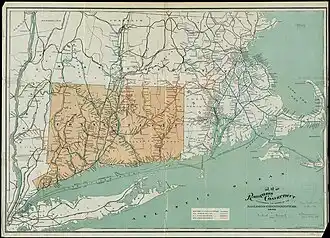
Connecticut’s historical migration routes are deeply entwined with its geographical advantages, economic developments, and shifting sociopolitical landscapes. From the earliest settlement patterns of Algonquian-speaking tribes to the successive waves of European arrivals, Connecticut’s coastline, rivers, and fertile valleys attracted diverse groups pursuing new opportunities or seeking refuge. Over time, the state’s evolving industrial centers drew large numbers of immigrants from Ireland, Southern and Eastern Europe, and, later, from Latin America, the Caribbean, and Asia. In doing so, Connecticut became a pivotal destination for those in search of religious autonomy, economic prosperity, and social advancement.
Through these successive movements, distinct communities formed, each contributing to the state’s cultural tapestry and economic foundations. The intersections of sea trade, inland waterways, and rapidly growing urban industries have continuously reshaped the demographic landscape, underscoring the enduring role of migration in forging Connecticut’s identity. Studying these migration routes not only highlights the factors that impelled people to relocate—ranging from famine, forced displacement, and political unrest to the lure of industrial employment—but also reveals how these journeys laid the groundwork for Connecticut’s social, economic, and cultural evolution.
Research your ancestors on MyHeritage
List of Connecticut historical migration routesList of Connecticut historical migration routes
| Time Period | Ethnic Group | Origination Location | Arrival Location | Motivating Factors |
|---|---|---|---|---|
| Pre-colonial (before 17th century) | Various Algonquian-speaking Tribes (e.g., Pequot, Mohegan, Narragansett) | Inland areas of southern New England and surrounding territories | Coastal and riverine regions of what is now Connecticut[1] | Seasonal mobility for hunting, fishing, and trade; establishment of permanent villages near arable land and waterways |
| Early 17th century | Dutch Traders | New Netherland (modern-day New York) | Hartford area (Dutch Fort Goede Hoop), along the Connecticut River | Fur trade and establishment of trading posts |
| 1630s – 1700 | English Puritans | Primarily Massachusetts Bay Colony and England | Windsor, Wethersfield, Hartford, and other early Connecticut towns | Search for religious and political autonomy; availability of fertile farmland |
| 18th century | Enslaved Africans | West Africa (trans-Atlantic slave trade), Caribbean | Coastal and inland plantations, households of Connecticut colonists | Forced migration due to the trans-Atlantic slave trade and economic demand for labor |
| Mid-19th century | Irish Immigrants | Ireland | Urban centers (e.g., Hartford, New Haven, Bridgeport) | Escaping the Great Famine (1845–1849); seeking industrial and construction jobs |
| Late 19th – Early 20th century | Italian, Polish, and Other Southern & Eastern European Groups | Southern Italy, Poland, and other parts of Europe | Growing industrial cities (e.g., Waterbury, Bridgeport, New Britain) | Economic opportunity in factories, mills, and construction; chain migration through established ethnic communities |
| Early – Mid-20th century | African Americans (Great Migration) | Southern United States | Hartford, New Haven, Bridgeport, and other industrial hubs | Escaping Jim Crow segregation; seeking better employment in northern industries |
| Mid – Late 20th century | Puerto Ricans and Other Latin American Groups | Puerto Rico, Dominican Republic, and various Latin American countries | Hartford region (particularly the Clay Arsenal neighborhood), Bridgeport, New Haven | Economic opportunity; movement facilitated by U.S. citizenship for Puerto Ricans; industrial and service-sector jobs |
| Late 20th – Early 21st century | Southeast Asian (Vietnamese, Cambodian, Laotian, Hmong), West Indian, African, and other Global Immigrant Communities | Southeast Asia, Caribbean nations, Africa, and beyond | Diverse urban and suburban areas throughout Connecticut | Refuge from war and political turmoil (Southeast Asia); family reunification; pursuit of educational and economic advancement |

